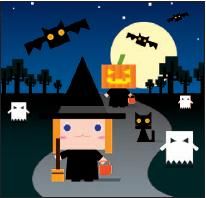Halloweenmania
When I was growing up in Brooklyn in the 1950s, kids started their preparations for Halloween after dinner on October 31. We would find an old mask, or make one out of a paper bag; wealthier kids might buy one. I would grab a pillowcase to hold my "loot" and take off. Neighbors would give us store-bought candy or homemade cookies or cupcakes. It didn't occur to anyone that an unwrapped, unsealed item could be dangerous. Older kids were the real danger: they would steal our goodies and often beat us up.

When I was growing up in Brooklyn in the 1950s, kids started their preparations for Halloween after dinner on October 31. We would find an old mask, or make one out of a paper bag; wealthier kids might buy one. I would grab a pillowcase to hold my "loot" and take off. Neighbors would give us store-bought candy or homemade cookies or cupcakes. It didn't occur to anyone that an unwrapped, unsealed item could be dangerous. Older kids were the real danger: they would steal our goodies and often beat us up.
Fast-forward 50 years. The average American, according to The New York Times, spends nearly $65 on Halloween.1 Most of this money is spent on costumes, including costumes for pets. The holiday of Halloween, an ancient pagan festival that later was made to coincide with the eve of All Saints' Day ("All Hallow Even"), seems to induce a decorating and partying mania in adults. Other than the abundance of tombstones, dismembered limbs, and skeletons on people's lawns, are there some substantial reasons to dislike Halloween?
Candies that contain foreign bodies (eg, pins, razor blades) may be what parents first think of, but incidents of candy-tampering are extremely rare. The x-raying of Halloween candy has a very low yield. Moreover, it is an expensive process (costing, on average, more than $3 to scan a single child's bag of candy), produces unnecessary crowds in radiology departments, and may even disrupt hospital functioning.
However, Halloween does pose several very real dangers to children. Eye injuries, some serious, have been seen in the United States and the United Kingdom as a result of eggs thrown on Halloween. Sorbitol-sweetened candies, when eaten in excess, may produce diarrhea. More college students who wear costumes to Halloween parties drink alcohol than do students who don't come in costume.2
What is most worrisome is that children are 4 times more likely to be hit and injured by a car on Halloween than they are on any other night. There is also a 4-fold increase in deaths of child pedestrians on Halloween, compared with other nights.3
I know Halloween is not going to go away. I know that children love trick-or-treating. I'd just like to see adults supervise their children better to prevent serious injuries that night. Would it be too much to also ask them to take some of that ugly stuff off their lawns?
References:
REFERENCES:
1.
Kramer L. Where the jack-o'-lanterns are only the beginning.
The New York Times.
October 21, 2007.
2.
Miller KA, Jasper CR, Hill DR. Dressing in costume and the use of alcohol, marijuana, and other drugs by college students.
Adolescence.
1993;28:189-198.
3.
Centers for Disease Control and Prevention (CDC). Childhood pedestrian deaths during Halloween-United States, 1975-1996.
MMWR.
1997;46:987-990.